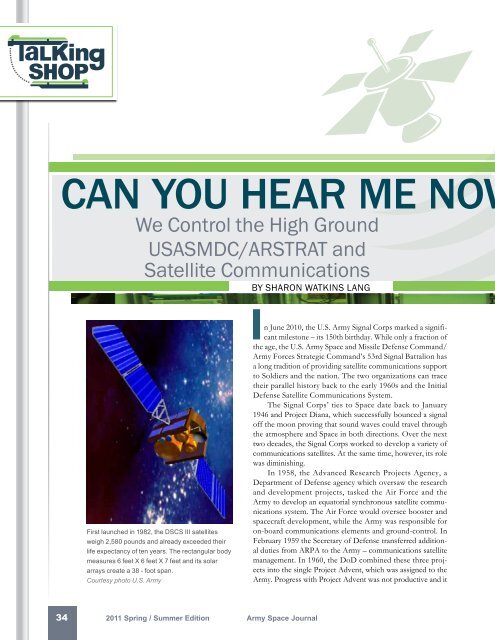Spring 2011 - Space and Missile Defense Command - U.S. Army
Spring 2011 - Space and Missile Defense Command - U.S. Army
Spring 2011 - Space and Missile Defense Command - U.S. Army
You also want an ePaper? Increase the reach of your titles
YUMPU automatically turns print PDFs into web optimized ePapers that Google loves.
Can you hear me Now<br />
We Control the High Ground<br />
USASMDC/ARSTRAT <strong>and</strong><br />
Satellite Communications<br />
By Sharon Watkins Lang<br />
First launched in 1982, the DSCS III satellites<br />
weigh 2,580 pounds <strong>and</strong> already exceeded their<br />
life expectancy of ten years. The rectangular body<br />
measures 6 feet X 6 feet X 7 feet <strong>and</strong> its solar<br />
arrays create a 38 - foot span.<br />
Courtesy photo U.S. <strong>Army</strong><br />
In June 2010, the U.S. <strong>Army</strong> Signal Corps marked a significant<br />
milestone – its 150th birthday. While only a fraction of<br />
the age, the U.S. <strong>Army</strong> <strong>Space</strong> <strong>and</strong> <strong>Missile</strong> <strong>Defense</strong> Comm<strong>and</strong>/<br />
<strong>Army</strong> Forces Strategic Comm<strong>and</strong>’s 53rd Signal Battalion has<br />
a long tradition of providing satellite communications support<br />
to Soldiers <strong>and</strong> the nation. The two organizations can trace<br />
their parallel history back to the early 1960s <strong>and</strong> the Initial<br />
<strong>Defense</strong> Satellite Communications System.<br />
The Signal Corps’ ties to <strong>Space</strong> date back to January<br />
1946 <strong>and</strong> Project Diana, which successfully bounced a signal<br />
off the moon proving that sound waves could travel through<br />
the atmosphere <strong>and</strong> <strong>Space</strong> in both directions. Over the next<br />
two decades, the Signal Corps worked to develop a variety of<br />
communications satellites. At the same time, however, its role<br />
was diminishing.<br />
In 1958, the Advanced Research Projects Agency, a<br />
Department of <strong>Defense</strong> agency which oversaw the research<br />
<strong>and</strong> development projects, tasked the Air Force <strong>and</strong> the<br />
<strong>Army</strong> to develop an equatorial synchronous satellite communications<br />
system. The Air Force would oversee booster <strong>and</strong><br />
spacecraft development, while the <strong>Army</strong> was responsible for<br />
on-board communications elements <strong>and</strong> ground-control. In<br />
February 1959 the Secretary of <strong>Defense</strong> transferred additional<br />
duties from ARPA to the <strong>Army</strong> – communications satellite<br />
management. In 1960, the DoD combined these three projects<br />
into the single Project Advent, which was assigned to the<br />
<strong>Army</strong>. Progress with Project Advent was not productive <strong>and</strong> it<br />
34<br />
<strong>2011</strong> <strong>Spring</strong> / Summer Edition <strong>Army</strong> <strong>Space</strong> Journal
















